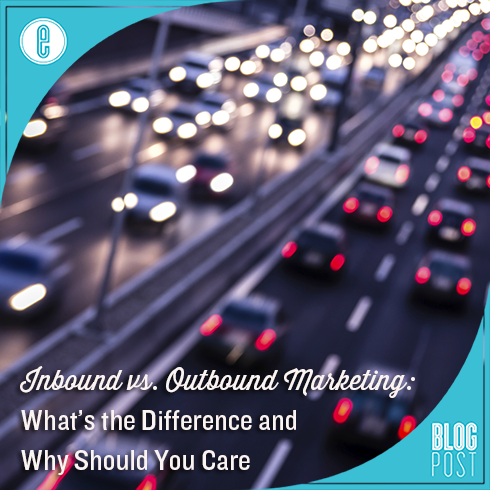Marketing has always been an effective way to grow a business. As the number of marketing channels grew, so did the number of businesses promoting themselves. It wasn’t long before consumers were so overwhelmed with marketing messages that they started tuning them all out.
Since ads and sales pitches weren’t working anymore, businesses had to find a new way to reach customers. This led to the growth of inbound marketing, which is more interactive, less intrusive, and more affordable than traditional, or outbound marketing.
Consumers have shown a clear preference for inbound vs. outbound marketing:
- Content marketing generates 3 times more leads than traditional marketing.
- Inbound marketing converts 2 to 5 times more leads than outbound marketing.
- When learning about a company, 70 percent of consumers prefer articles over advertising.
However, this doesn’t make inbound marketing any easier to implement. The whole concept of inbound vs. outbound marketing may be new or confusing, but understanding the difference is the only way your business is going to gain traction in the marketplace.
Inbound vs. Outbound Marketing: A Side-by-side Comparison
The goals for inbound and outbound marketing are similar, but the tactics aren’t. Outbound marketing is a new term, but the practice is exactly what’s been done for years:
- Cold-calling sales prospects
- Advertising on TV, newspapers, and other mass media
- Sending brochures and flyers to potential customers
In each case, the business makes an offer to a broad audience and consumers can either respond or ignore it. Also, these ads often appear on mass media channels, which don’t give much control to consumers.
The internet, on the other hand, gives consumers a lot of control over the marketing process. They can choose which messages they want to hear and so gravitate towards the organizations that provide it. Instead of pushing the messages they want to tell, businesses had to craft messages consumers wanted to hear, often in the form of:
- Blogs
- White papers
- Videos
- Podcasts
- Social media posts
The ultimate goal is the same – higher revenues and sales – but inbound marketing does this through long-term engagement rather than short-term transactions.
How Does This Difference Impact Marketing?
Despite the resounding success of inbound vs. outbound marketing, many marketers are still trying to figure out how it works. Several aspects are similar; for instance, it’s still important to define your goals and measure the results of your efforts. Others don’t resemble traditional marketing at all.
Communication
Traditional ads tout a product, and the consumer can either look at them or ignore them. Direct mail does the same thing but also offers a way for customers to respond. Inbound marketing allows consumers to respond any way they see fit.
Of course, some consumers respond with a purchase, but they’re more likely to take another action, such as liking or sharing content, leaving comments or signing up to a mailing list or news feed. The interaction is more complex, but it also ensures a stronger relationship and a higher return on investment.
Costs
For many small and startup businesses, traditional advertising costs are so high that they only have enough money for a small-scale campaign – if they advertise at all. Inbound marketing, by contrast, allows small companies to compete with larger businesses for customers and sales.
Instead of buying ad space, you pay for the costs of creating content – writers, designers, and social media experts – and for the cost of measuring the results. The final cost may be lower than that of a traditional ad campaign, but when you consider what it generates – twice as many leads and higher ROI – the value of inbound marketing is incalculable.
Value Proposition
It can be confusing to determine the best offer for inbound vs. outbound marketing efforts. After all, isn’t the whole objective to make more money? It is, of course, but the same hard sell that makes outbound marketing so effective could backfire in inbound marketing.
When a site visitor reads your blog, he or she isn’t looking for a sales pitch – he or she is looking to learn something or get advice. The expectations are very different, so inbound marketing content should focus more on what would educate or entertain the consumer than what would boost your short-term sales.
There’s still plenty of room for traditional marketing in your strategy. If you want to stand out from the competition, increase customer loyalty, and generate more revenues from fewer dollars, inbound marketing will need to take a larger role.
-FINAL(01-00)-White&Blue-01.svg)





